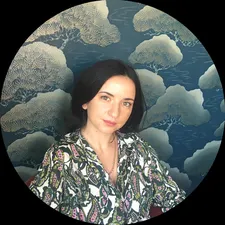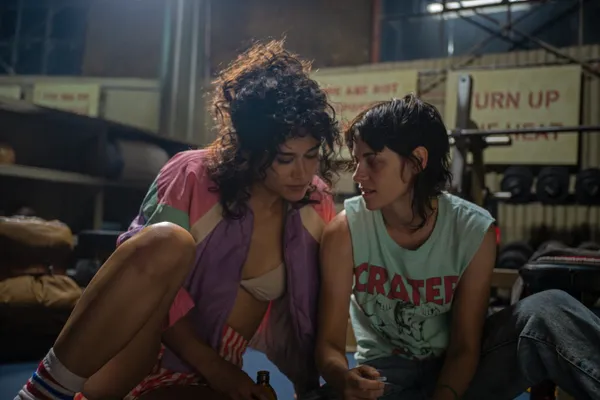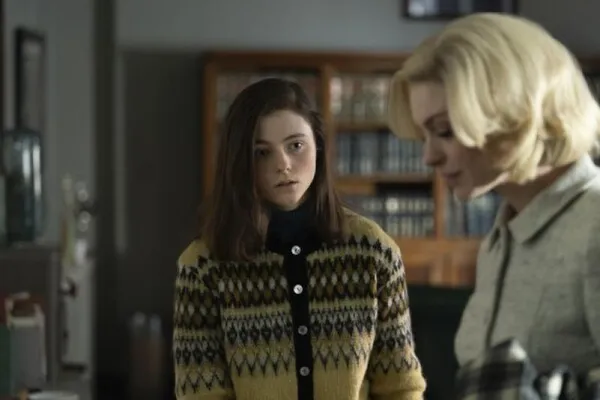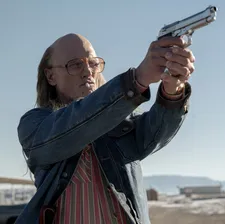Love Lies Bleeding, the latest thriller from Rose Glass, has energy and style to burn. Kristen Stewart stars as mousy gym worker Lou who falls hard and fast for sculpted bodybuilder Jackie (Katy O'Brian) after she stops off in her small town on the way to a competition in Vegas. The pair fall hard and fast for each other but Jackie’s increasing addiction to steroids coupled with Lou’s criminal family - headed by Ed Harris’ Lou Sr - create a powder keg that’s ready to blow. The film is set in the late-80s, a period reinforced by careful costuming from Olga Mill - who previously brought her skills to William Oldroyd’s Sixties-set Eileen. We caught up with the designer, who also has films including Hereditary and Never Rarely Sometimes Always on her CV, to talk about the challenges of her various projects.
Love Lies Bleeding is slightly unusual in being set towards the end of the Eighties and in that it features a lot of gym gear even though it’s not exclusively set in the sporting world, so how did you approach it?
Olga Mill: My approach was research, a lot of research. Also just talking to Rose about how we wanted to approach the period. I think a lot of times, the Eighties can get really cartoonish really quickly. And it's really tempting to be, like, neon and shoulder pads…
And leg warmers…
OM: Yes, the Eighties does have a certain gym aesthetic that can attract you like a moth to light. You just want to go there because there are so many iconic gym looks from that period. And we wanted to do something a little different and really ground it. The way that it starts with an opening montage of people working out, that's not like a glamorous, leg warmer, leotard version of working out. When I went to go do research, I really tried to stay away from the kind of bubblegum gym version, like Let's Get Physical and Flashdance and all and all of that.
I tried to research real people, so not just looking at magazines. The Eighties is a great period to research because people already had their own personal family cameras and so the idea of finding candid research becomes more accessible than earlier periods. So I did that to try to kind of ground it. I also set a colour palette that felt kind a little washed out and dusty and sort of primary colours and a little bit of pastels and not really dipping into like a neon world.
There’s some interesting colour coding in the film. Although Kristen Stewart’s Lou wears some primary colours, on the whole her platte is a lot more muted. Whereas Katy O’Brian’s Character has a lot more pastel colors and she’s more colorful. Is tht something you wanted to lean into, the idea of this incomer being more vibrant than the environment?
OM: Totally. Jackie catches Lou’s eye in every way. There’s her physicality, but also she's a brighter colour that comes into the world. And then I think that grows by the time we get to Vegas and that competition - those bathing suits is really the only time we see a really saturated neon palette.
Ed Harris gets some real eye-poppers as Lou Sr too, these shirts with incredibly busy patterns. What was your approach to his character.
OM: That one was an interesting, really hard and fun nut to crack. It's funny but just in preparation for this chat, I went through and looked at my research boards to try to jog some memories which I can share with you but on all the Lou Sr pages the conversations kind of stemmed around not wanting to make him an overtly menacing guy. He's menacing enough in his actions. His look, the hair, all of that is so strange. But his clothes don't need to signal, in terms of colour, dark colours or a bad guy looming. I remember at one point Rose and I were sort of just shooting the shit about him and we were like, “You know, he's probably somebody who has a good backyard barbecue hang.” There is another side of him. One of those people, who if you get too close, they're really scary. You know, he's even scary in that little intro meeting with Jackie at the gun range. But there is a sense of if you were to walk into a backyard barbecue pool party, and he was there at the grill that there would be something that's a little bit jovial visually about him.
So was Lou’s playlist quite different from Jackie’s? I’m curious now.
OM: Yeah they were different. Jackie's was more like something you’d be listening to while you’re going to work out. Pump you up music. What I thought was really sweet about Lou’s was that it was music that you want to drive to. Some of it was quite romantic but it really encompassed that feeling of, “Oh, I just want to like, drive and smoke cigarettes and daydream about someone I have a crush on.”
How does Daisy (Anna Baryshnikov) - a small-town girl who has a crush on Stewart’s Lou - fit into all that? Because again, she has quite a different look. Her character is deliberately there to contrast with the other two and it’s there in the styling.
OM: Anna and I had a lot of fun. She reminded me at Sundance. And she was like, “Do you remember ‘dirty flip-flop’?” She had to jog my memory, but in her first fitting, we were trying things on and she is such a good actress and the costume had to work really hard to make her unattractive to Lou because she is a very attractive person. And she was like, “Do you remember during our fitting, at some point you said, ‘Daisy’s kind of like a dirty flip-flop’?” And that was like an anchor for us.
She reminded me of the feeling of summer. I grew up in New York and if you ever walk around the city and flip-flops like I did as a teenager, that feeling of the bottoms of your feet being like black to the point where you can't wash them any more. That was anchor to her character - when like you're having a good time for too long, and it becomes gross.
There’s also a lot of denim going on in this film, particularly Jackie’s very short raggy bottomoned cut-offs
OM: Those shorts are so simple, but took some like NASA engineering.
Katy O’Brian is very muscular, which I wanted to ask you about. I imagine, generally speaking, as a costume designer, you're designing for extremely slim actresses, they’re often straight up and down. Whereas Jackie has a real physicality. So I imagine that was a little bit different for you.
OM: I think it's getting better. There's more and more, I don't know, big quotation around “normal bodies” coming through.That is getting better. But hers is so specific. I've never worked with somebody that is a bodybuilder. And her body was evolving from our first fitting because she was training so intensely. So we constantly had to keep adjusting.
So you went through a fair few pairs of shorts?
We really did have to keep an eye on it. Actors, just as human beings, fluctuate, throughout the month, throughout a few months, especially when you're working so much. So there's always that, but yes, it took me I almost feel like a few goes to sort of crack the code of what is going to really feature her muscles. There's this really interesting documentary that I watched called Pumping Iron: The women, it’s on Youtube. It was so interesting. It was about bodybuilders in the Eighties. And there's like this big conversation around whether those women in the competition should look really feminine. And like how does femininity butt up against strength. Whether those are actually two different things, and you shouldn't look sexy and strong. Or whether there's a world where those two live together. And you see bodybuilders from that time period, some have a sexy, earrings, make-up, traditionally feminine vibe and are sort of trying to use sex appeal. And then you see some bodybuilders that give a vibe more like, “I'm an Olympic athlete, I want to be a bodybuilder the way that the guys are, and I shouldn't have to put make-up on and be in heels like this should just be about my strength.” There's no right or wrong. It was just an interesting debate.
And we can’t chat to you without briefly discussing Eileen, which is another terrific period piece you did. With Love Lies Bleeding, I felt like it was a lot about tones and shades in the costuming. With Eileen, I feel like it's a lot more about textures.
OM: I'm so glad that came through.
There’s a layered, textured wooly thing that's going on in Eileen. Why did you decide to approach it that way and how did you set about it?
OM: The texture of it was the first thing that unlocked it for me. When you first start designing a film, it just feels like you're kind of like, desperately “I'll touch anything, I'll look at anything”, to see what I can hold on to so you don't fall off the cliff. For Eileen, just reading the book and the script made me think about how uncomfortable Eileen is in her world. I'm not a winter person. So the idea of that feeling of an itchy sweater or wet socks, the way that that viscerally makes you so uncomfortable that it's almost like you want to throw up and you're angry when you're wearing an itchy sweater or wet wool socks. So that was sort of in my mind. I wanted it to feel viscerally uncomfortable. And then I somehow, I don't know how, ended up looking at pictures of molds on food.
That can be quite furry too.
OM: Yes! Then these things kind of melded together? Where I was looking at all of these beautiful close up pictures of mold on bread or raspberries where it's green, but then has a white fuzziness on top. Then early on, I like to go to a rental house and just sort of start looking around and see what feels right or no. As if you're the character roleplaying, and it's like, what would Eileen gravitate towards? And I started to notice that from the kind of like late 50s.
So when I started looking at those textures, I was like, “Oh, there's a lot of bouclet or wool or knits that actually have almost the feeling of that moldiness - there's a color but then there's like a mohair fuzz on top of it”. And so then those two things felt a little bit like Kismet that they were working together. And then that was helpful for me when looking at 20 different sweaters and you're like, “Ooh, which one do I pick?” I tried to be like, “Okay, which one feels like mold? Which one feels uncomfortable?” Because I find it's good to have a kind of guiding light so you can make big and small decisions from kind of the same point.
In both those films you really feel the contribution the costumes make to the character
OM: I think it was in the script. And I think it also is a testimony to Will and to Rose. But yeah, I feel like I did super-naturalistic films for a little bit like Never Rarely Sometimes Always. With every project, I try to ask the director, “Are the costumes whispering? Are they at a conversational volume? Do we want them to be screaming at any point”. So these two projects were particularly fun, because I think the volume is like a little bit turned up.
That’s interesting because I’m sure whispery costumes are tricky too
OM: They're the hardest like. In Never Rarely, they have to whisper so you never want anybody to even think about it but also they are in those clothes for so long. Yeah. But yes, very different assignments. In Love Lies, Bleeding it was how do we make these really recognisable, really iconic, really graphic? Versus Never Rarely, where it's like, how do you make it as naturalistic and unnoticeable as possible. I like both. I mean, from an ego level, you like being able to peacock a little bit, but I think in an analytical way, both assignments are really interesting. And I guess that's what's cool about doing this as it's different on each project.
Love Lies Bleeding is released by A24 in the US on March 8 and in the UK on May 3

























